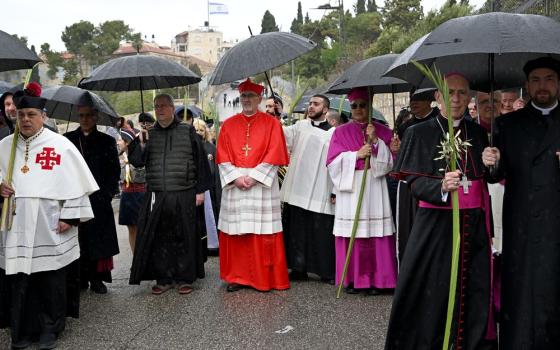
"The Holy Trinity" by Albrecht Dürer, 1511 (Metropolitan Museum of Art)
As church, we resist moving beyond the Easter season. So, after 50 days of alleluia extravaganza, we ease out with two mega mysteries before we admit that Sundays can be "Ordinary Time." Although fairly vague about our precise theology, all Christians proclaim that God is a Trinity and Catholics in particular emphasize the "real presence" of Christ in the Eucharist. These are the themes of the feast days that usher us out of our 50 days of Easter.
Our celebration of the Trinity invites us to take time to contemplate what God is like and what that means for us. We claim that God is a Trinity of being: three persons who are one God, a uniquely Christian belief that sounds like blasphemy to some world religions and nonsense to others. St. Patrick and the shamrock aside, the only way to approach this idea is to contemplate it as a mystery. That means to mull it over with an attitude that revels in awe and lets go of the need for clear answers. God's Trinitarian being is a mystery in the deepest sense of the word, a reality that fascinates us, draws us toward God, and is too deep for our thought and prayer to exhaust.
If we were to choose background music to accompany our first reading, I would suggest "Appalachian Spring" by Aaron Copeland. We could all do well by spending 27 minutes allowing this music to inspire our imagination of the Lady Wisdom described in Proverbs. In the music's slow, quiet beginning, we can hear whispers hinting at God's wisdom-presence "poured forth" from of old. In the "allegros," we can imagine her delighting God as she dances over the surface of the earth. The music, like the reading, invites us to envision the divine joy that has suffused creation from the beginning until now.
It was not a huge leap for the early Christians to connect the figure of Lady Wisdom with the Jesus who had walked among them, been executed, and returned to them transfigured in resurrection. They knew from experience that he made God present to them as no one ever had. When their hearts burned listening to him, it was easy to conceive of him as the one who said, "From of old I was poured forth." When they experienced the things of which Paul speaks — peace with God, boasting in hope, the love of God poured out in their hearts — each of those experiences conveyed them into the realm of what they could only name as the Holy Spirit given to them. Little by little, they began to develop a new understanding of God as present to them in three uniquely personal ways.
The Gospel of John, written 60 years or more after the resurrection, is the result of decades of faith-filled reflection on the life and teaching of Jesus. More than any other evangelist, John portrayed Jesus' intimate communion with God whom he called Father. John also explained how Jesus' relationship with the Father could not be separated from his promise that his followers are capable of sharing that same relationship with him and the Father through the Spirit.
Advertisement
With this, we begin to see what God's Trinitarian being has to do with us. As theologian Catherine LaCugna described it 30 years ago in God For Us, when we contemplate God as Trinity, we see God as Father, Son and Spirit creating, being incarnate and pouring self out in us so that they can draw all of creation into divine life.
That, like the explanations of theologians such as St. Basil the Great or Thomas Aquinas or Karl Rahner, can sound too complicated for most mortals on a Sunday morning. Put more simply, Christians believe that God is, as LaCugna taught, a God whose very being is communal love and who created in order to share that love. That means that we who are created in the image of God are created to find our greatest fulfillment as images of the Trinity: enjoying relationships with one another, with God and with all of God's creation.
When we realize this, we understand that the Solemnity of the Most Holy Trinity recapitulates everything we have been celebrating for the 50 days of Easter. If you have to explain it to a child, teach her the Sign of the Cross and say that it means that God loves us in more ways that we can count.







